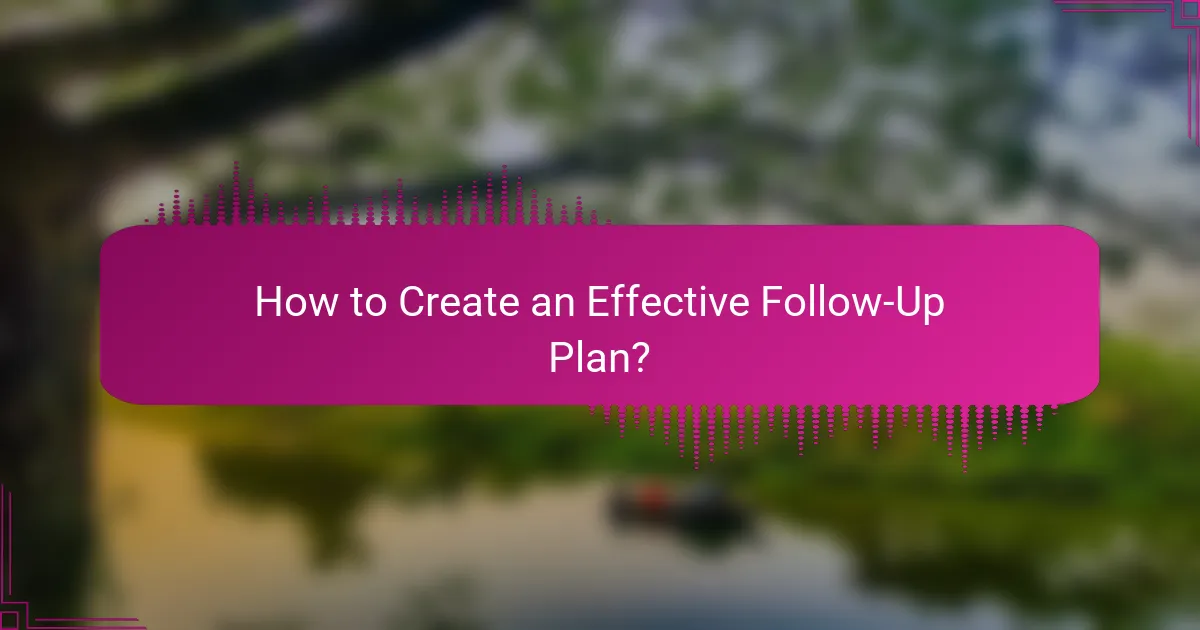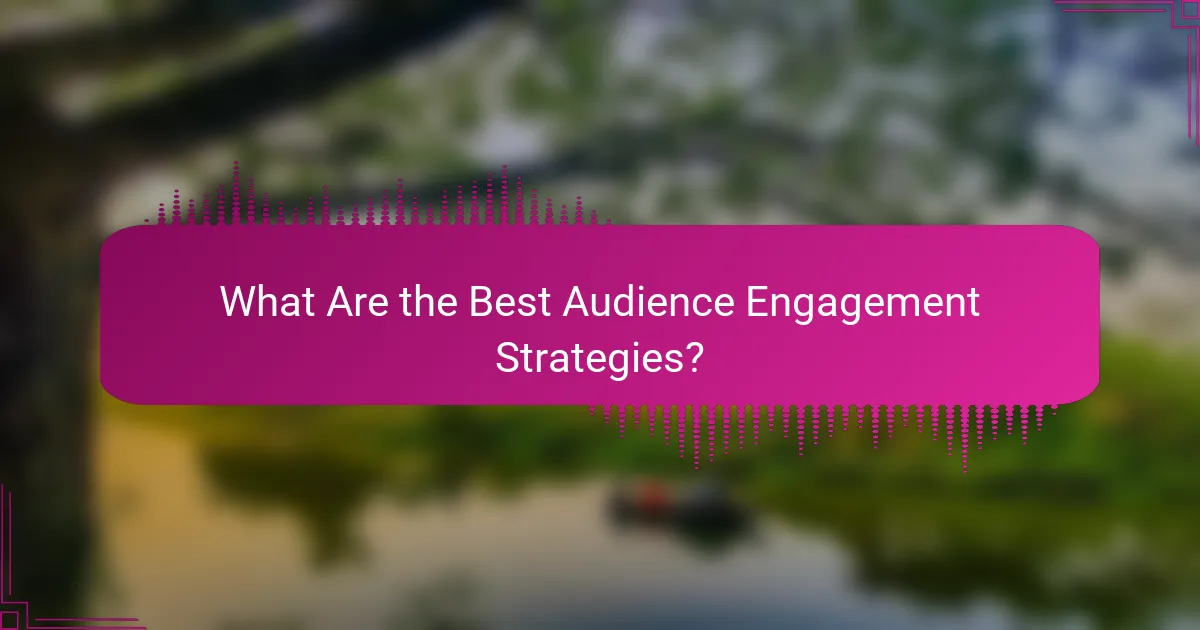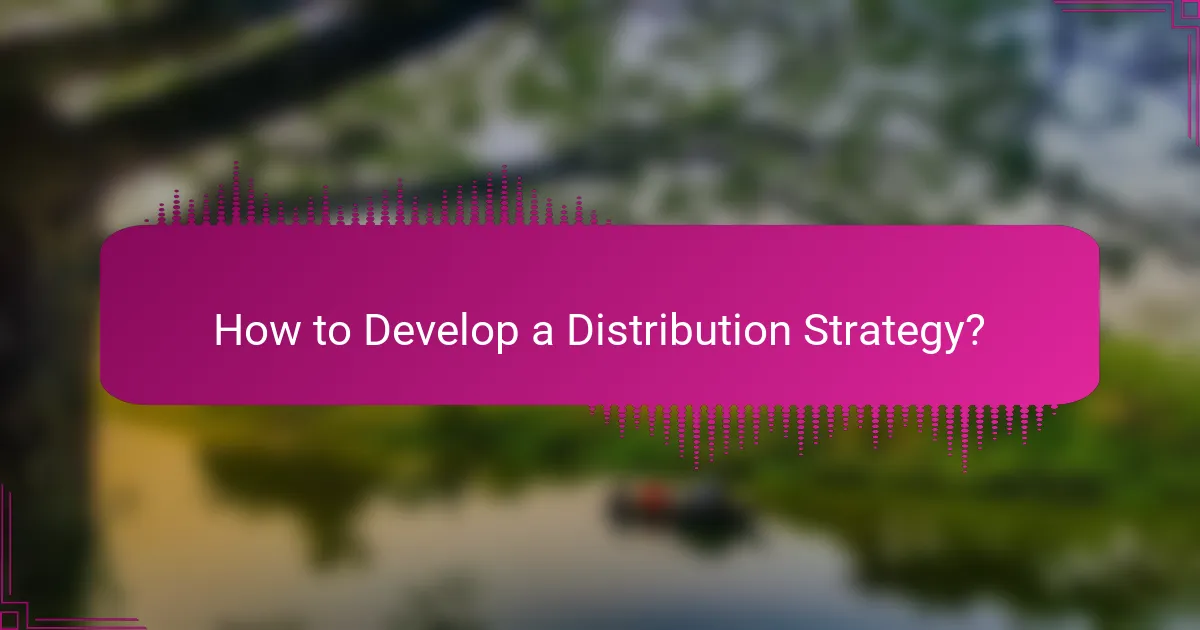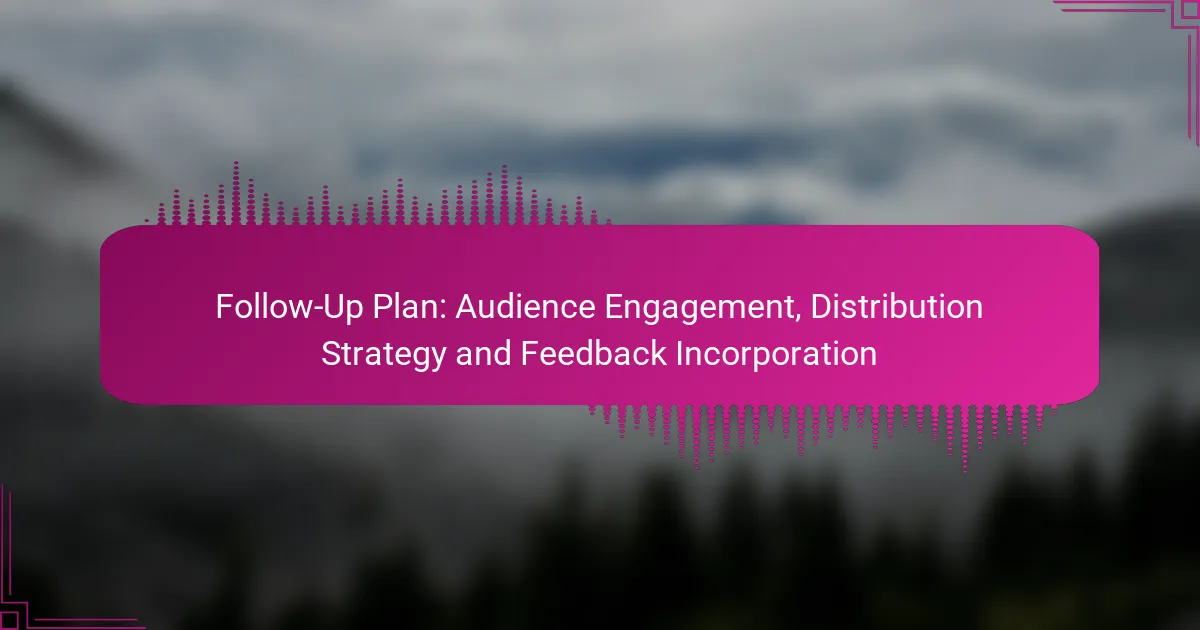A well-structured follow-up plan is crucial for enhancing audience engagement, optimizing content distribution, and effectively incorporating feedback. By clearly defining your audience and goals, selecting appropriate channels, and utilizing automation tools, you can create meaningful interactions that resonate with your target demographic. This strategic approach not only fosters loyalty and participation but also drives continuous improvement in your initiatives.

How to Create an Effective Follow-Up Plan?
An effective follow-up plan enhances audience engagement, ensures proper distribution of content, and incorporates feedback for continuous improvement. It involves defining your audience, setting clear goals, selecting appropriate communication channels, establishing a timeline, and utilizing automation tools.
Define audience segments
Identifying audience segments is crucial for tailoring your follow-up approach. Consider demographics, interests, and behaviors to create distinct groups that will respond differently to your messages.
For instance, segmenting by age or profession can help you craft personalized content that resonates more deeply. This targeted strategy can significantly improve engagement rates and overall effectiveness.
Set clear objectives
Establishing clear objectives is essential for measuring the success of your follow-up plan. Objectives should be specific, measurable, achievable, relevant, and time-bound (SMART).
Examples of objectives include increasing email open rates by a certain percentage or boosting social media engagement within a specified timeframe. Clear goals help focus your efforts and provide benchmarks for evaluation.
Choose communication channels
Selecting the right communication channels is vital for reaching your audience effectively. Options include email, social media, SMS, or even direct mail, depending on where your audience is most active.
Consider the preferences of your audience segments when choosing channels. For example, younger audiences may prefer social media, while professionals might respond better to email communications.
Establish a timeline
A well-defined timeline helps keep your follow-up plan organized and timely. Determine when to send follow-ups based on your audience’s engagement patterns and the nature of your content.
For instance, if you’re following up after an event, aim to reach out within a few days while the experience is still fresh. Regular check-ins, such as monthly newsletters, can also keep your audience engaged over time.
Utilize automation tools
Automation tools can streamline your follow-up processes, saving time and ensuring consistency. Tools like email marketing platforms or CRM systems can help schedule and personalize communications based on audience behavior.
For example, automated responses can be set up for new subscribers, providing them with immediate engagement. However, ensure that automation does not compromise the personal touch that builds relationships with your audience.

What Are the Best Audience Engagement Strategies?
Effective audience engagement strategies focus on creating meaningful interactions that resonate with your target audience. These strategies enhance communication, foster loyalty, and encourage participation, ultimately driving better results for your initiatives.
Personalized messaging
Personalized messaging tailors content to individual preferences, behaviors, or demographics, making communications more relevant. This can include using the recipient’s name, suggesting products based on previous purchases, or segmenting audiences by interests.
To implement personalized messaging, utilize data analytics tools to gather insights about your audience. Aim for high levels of customization, but avoid overwhelming users with excessive information that may feel intrusive.
Interactive content
Interactive content engages audiences by inviting them to participate actively, rather than passively consuming information. Examples include quizzes, polls, and interactive infographics that encourage users to explore content in a hands-on manner.
Consider incorporating interactive elements into your digital platforms to boost engagement. These tools not only enhance user experience but also provide valuable data on audience preferences and behaviors, which can inform future strategies.
Regular updates
Regular updates keep your audience informed and engaged by providing fresh content and insights. This can include newsletters, blog posts, or social media updates that share news, tips, or industry trends relevant to your audience.
Establish a consistent schedule for updates to maintain audience interest. Aim for a balance between frequency and quality; too many updates may overwhelm subscribers, while too few can lead to disengagement.
Surveys and polls
Surveys and polls are effective tools for gathering feedback and understanding audience preferences. By asking targeted questions, you can gain insights into what your audience values and how they perceive your content or services.
Make surveys and polls easy to access and complete, and consider offering incentives for participation. Analyze the results to identify trends and areas for improvement, ensuring that your audience feels heard and valued.

How to Develop a Distribution Strategy?
A distribution strategy outlines how to effectively share your content with your target audience. It involves selecting the right platforms, optimizing content for each channel, and scheduling posts to maximize engagement.
Select appropriate platforms
Choosing the right platforms is crucial for reaching your audience effectively. Consider where your target demographic spends their time, whether it’s social media sites like Facebook and Instagram, professional networks like LinkedIn, or content-sharing platforms like Medium.
Analyze the strengths of each platform. For instance, visual content performs well on Instagram, while in-depth articles are better suited for LinkedIn. This alignment ensures your content resonates with the audience on each platform.
Optimize content for each channel
Content optimization involves tailoring your message to fit the unique characteristics of each platform. For example, use shorter, punchy headlines for Twitter, while longer, more detailed posts may work better on Facebook or LinkedIn.
Incorporate platform-specific features, such as hashtags on Instagram or links on Twitter, to enhance visibility. Always maintain a consistent brand voice, but adjust the format and style to suit the audience’s expectations on each channel.
Schedule posts for maximum reach
Timing is essential for maximizing engagement. Research suggests that posting during peak hours—typically early mornings or late afternoons—can significantly increase visibility. Use analytics tools to identify when your audience is most active.
Consider creating a content calendar to plan and schedule your posts. This helps maintain a consistent presence and allows you to experiment with different posting times to see what yields the best results.

What Feedback Incorporation Techniques Work Best?
Effective feedback incorporation techniques focus on understanding audience engagement and making data-driven adjustments. Utilizing a combination of metrics analysis, surveys, and testing can significantly enhance audience interaction and satisfaction.
Analyze engagement metrics
Analyzing engagement metrics involves examining data such as click-through rates, time spent on content, and social media interactions. These metrics provide insights into what resonates with your audience and what doesn’t, allowing for targeted improvements.
Consider using tools like Google Analytics or social media insights to track these metrics. Look for trends over time rather than focusing on single data points, as this will give a clearer picture of audience behavior.
Conduct follow-up surveys
Follow-up surveys are a direct way to gather feedback from your audience about their experiences and preferences. These surveys can be distributed via email or embedded on your website, and they should include both quantitative and qualitative questions.
Keep surveys concise to encourage participation, aiming for completion times of under five minutes. Offering incentives, such as discounts or entry into a prize draw, can also increase response rates.
Implement A/B testing
A/B testing involves comparing two versions of content to determine which performs better. This technique allows you to test different headlines, images, or calls to action, providing clear data on what engages your audience more effectively.
When conducting A/B tests, ensure that you only change one variable at a time to accurately assess its impact. Aim for a sample size that is large enough to yield statistically significant results, typically in the hundreds or thousands, depending on your audience size.

What Tools Can Enhance Audience Engagement?
Effective audience engagement tools help businesses connect with their audience, streamline communication, and gather valuable feedback. Utilizing the right platforms can significantly improve interaction rates and overall satisfaction.
HubSpot for CRM
HubSpot is a comprehensive customer relationship management (CRM) tool that centralizes customer data, interactions, and insights. It allows businesses to track leads, manage customer relationships, and automate marketing efforts, making it easier to engage with audiences effectively.
Consider using HubSpot’s segmentation features to tailor your messaging based on customer behavior and preferences. This targeted approach can lead to higher engagement rates and more personalized experiences.
Mailchimp for email campaigns
Mailchimp is a popular platform for creating and managing email marketing campaigns. It offers user-friendly templates and automation tools that help businesses send targeted messages to their audience based on their interests and behaviors.
To maximize engagement, segment your email lists and personalize your content. Aim for a consistent sending schedule, and monitor open and click-through rates to refine your strategy over time.
Hootsuite for social media management
Hootsuite is a powerful social media management tool that allows businesses to schedule posts, monitor engagement, and analyze performance across multiple platforms. This centralized approach helps maintain a consistent online presence and engage with audiences effectively.
Utilize Hootsuite’s analytics to track which types of content resonate most with your audience. Regularly adjust your strategy based on these insights to enhance engagement and foster community interaction.

What Metrics Should Be Tracked for Success?
To gauge success in audience engagement and distribution strategy, track metrics such as engagement rates, reach, and feedback scores. These indicators provide insights into how well your content resonates with your audience and its effectiveness in meeting objectives.
Engagement Rates
Engagement rates measure how actively your audience interacts with your content. This includes likes, shares, comments, and click-through rates. A higher engagement rate indicates that your audience finds the content valuable and relevant.
To calculate engagement rates, divide the total interactions by the total reach or impressions, then multiply by 100 to get a percentage. Aim for engagement rates above 1-2% for social media platforms and higher for email campaigns.
Reach
Reach refers to the total number of unique users who see your content. Understanding reach helps you assess the visibility of your distribution strategy. A broader reach can lead to more potential engagement and conversions.
Monitor reach across different platforms to identify where your audience is most active. Adjust your distribution strategy accordingly to focus on channels that yield the highest reach, such as social media or email newsletters.
Feedback Scores
Feedback scores provide qualitative insights into audience perceptions of your content. This can be gathered through surveys, polls, or direct comments. High feedback scores indicate that your content meets audience expectations and needs.
Consider implementing a simple rating system (e.g., 1-5 stars) or open-ended questions to gather detailed feedback. Regularly review this feedback to identify trends and areas for improvement in your content strategy.
